Email vs. Social Media Marketing
Marketing is the backbone of any successful business. But with so many options, it’s easy to get lost. One of the biggest debates in digital marketing is email marketing vs social media marketing. Which one drives better conversions? Which strategy gives you a higher return on investment? If you’ve ever wondered about these questions, you’re in the right place.
In this blog, we’ll break down email marketing statistics, and social media marketing statistics, and compare their effectiveness in real-world scenarios. We’ll discuss their pros and cons, how they impact conversions, and explore which one gives a better email marketing ROI or social media marketing ROI. Let’s dive in!
Why Businesses Need a Strong Marketing Strategy
The digital world is crowded. Businesses need a strategy that cuts through the noise and connects them with their audience. Whether running a small startup or a large corporation, a well-defined marketing strategy ensures you’re reaching the right people at the right time.
Both email marketing and social media marketing play crucial roles in building customer relationships, boosting engagement, and driving sales. But the big question remains: which one is more effective for conversions?

Understanding Email Marketing
What Is Email Marketing?

Email marketing is a direct form of communication where businesses send targeted emails to customers. It includes promotional messages, newsletters, personalized offers, and automated sequences. The goal is to nurture leads and convert them into paying customers.
Key Benefits of Email Marketing for Businesses
Higher Engagement
Email marketing is one of the most effective ways to directly reach customers. Unlike social media posts that can get lost in a crowded feed, emails land straight in a person’s inbox, making them harder to ignore. Studies show that email marketing statistics prove emails have higher engagement rates compared to social media. People check their emails daily, which increases the chances of your message being seen and acted upon.
Personalization for Better Connections
One major advantage of email marketing is personalization. Businesses can segment their audience based on demographics, purchase history, or behavior. This means they can send content that is relevant and valuable to each group. Personalized emails often have higher open rates and conversions because customers feel the message is tailored to their needs.
For example, an online clothing store can send different emails to men and women, showcasing products that match their preferences. A customer who recently purchased a winter coat might receive an email about matching gloves or scarves. This kind of targeted approach helps businesses build trust and drive sales.
Cost-effective with a High ROI
Compared to paid social media ads, email marketing is much more budget-friendly. Businesses can reach thousands of customers at a fraction of the cost of traditional advertising. Additionally, email marketing ROI (Return on Investment) is one of the highest in digital marketing. Studies show that for every 1 dollar spent on email marketing, businesses can earn an average return of 36 dollars. This makes it a smart investment for companies looking to maximize their profits.
Automated Workflows for Efficiency
Another key benefit of email marketing is automation. Businesses can set up automated email sequences to nurture leads, engage customers, and drive sales all without spending extra time on manual work. Automated emails can be triggered based on user actions, such as signing up for a newsletter, making a purchase, or abandoning a shopping cart.
Common Types of Email Marketing
Newsletters: Stay Connected with Your Audience
Newsletters are one of the most popular forms of email marketing. They help businesses stay in touch with their customers by sharing updates, industry news, and company announcements.
“A fitness brand could send a weekly newsletter featuring workout tips, healthy recipes, and new product launches. This keeps subscribers engaged and encourages them to visit the website regularly.”
Promotions: Drive Sales with Special Offers
Promotional emails are used to offer discounts, flash sales, and special deals to customers. These emails create urgency and encourage recipients to take action immediately.
“An online electronics store could send an email with the subject line: "Limited-Time Offer: 20% Off Smartphones – Today Only!" This kind of promotion can lead to a spike in sales within a short period”.
Automation Sequences: Convert Leads into Customers
Automated email sequences are pre-set emails that are sent based on customer behavior. These sequences can guide potential customers through the buying journey and help businesses retain existing customers.
“An e-commerce store could have an abandoned cart email sequence like this:
Email 1 : Reminder – "Oops! You Left Something in Your Cart."
Email 2 (24 hours later) : "Still Thinking? Here’s 10% Off Your Order!"
Email 3 (48 hours later) : "Last Chance! Your Cart Will Expire Soon!"
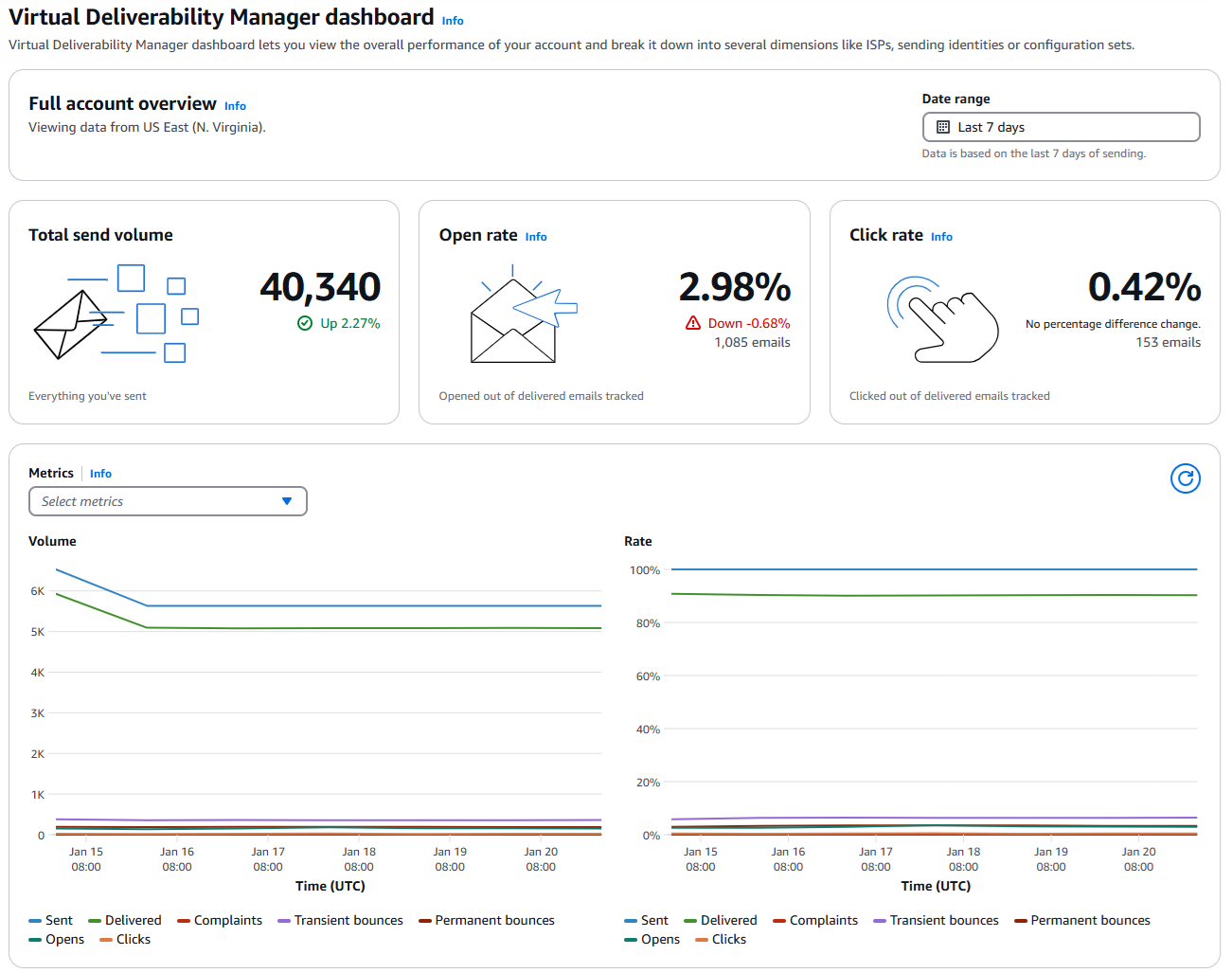
Understanding Social Media Marketing

What Is Social Media Marketing?
In today’s digital world, businesses need to be where their customers are—and that’s on social media. Social media marketing is a powerful way for brands to connect with their audience, promote products, and grow their presence online. It involves creating and sharing content on platforms like Facebook, Instagram, Twitter, and LinkedIn to engage users and drive traffic to websites.
Unlike traditional marketing, which relies on one-way communication, social media marketing allows businesses to have real conversations with their customers. Whether it's responding to comments, hosting live Q&A sessions, or sharing behind-the-scenes stories, brands can build relationships and create a loyal customer base.
How Does Social Media Marketing Work?
Social media marketing works by leveraging different types of content—such as images, videos, and text posts—to reach the right audience. Businesses can use organic posts to engage followers or paid advertisements to target potential customers based on their interests, location, and online behavior.
For example, a small bakery can use Instagram to share drool-worthy pictures of fresh pastries, while a tech company can use LinkedIn to post thought-leadership articles about industry trends. By tailoring content to each platform, businesses can maximize their reach and impact.
The Power of Engagement and Brand Awareness
One of the biggest advantages of social media marketing is its ability to boost engagement and brand awareness. Unlike other forms of marketing, social media allows businesses to interact with their audience in real time.
When customers like, share, or comment on a post, it signals to social media algorithms that the content is valuable. This increases its visibility, helping businesses reach even more people without spending extra money. The more engagement a brand gets, the stronger its online presence becomes.
For example, imagine a clothing brand launches a new product line. Posting a behind-the-scenes video showing the design process and encouraging followers to comment on their favorite styles creates excitement and engagement. People are more likely to tag their friends, leading to greater exposure and potential sales.
According to social media statistics, brands that actively engage with their audience see higher loyalty and customer retention. This is because social media gives businesses a chance to show their personality, respond to customer concerns quickly, and build long-term relationships.
Social Media Users worldwide by age and gender
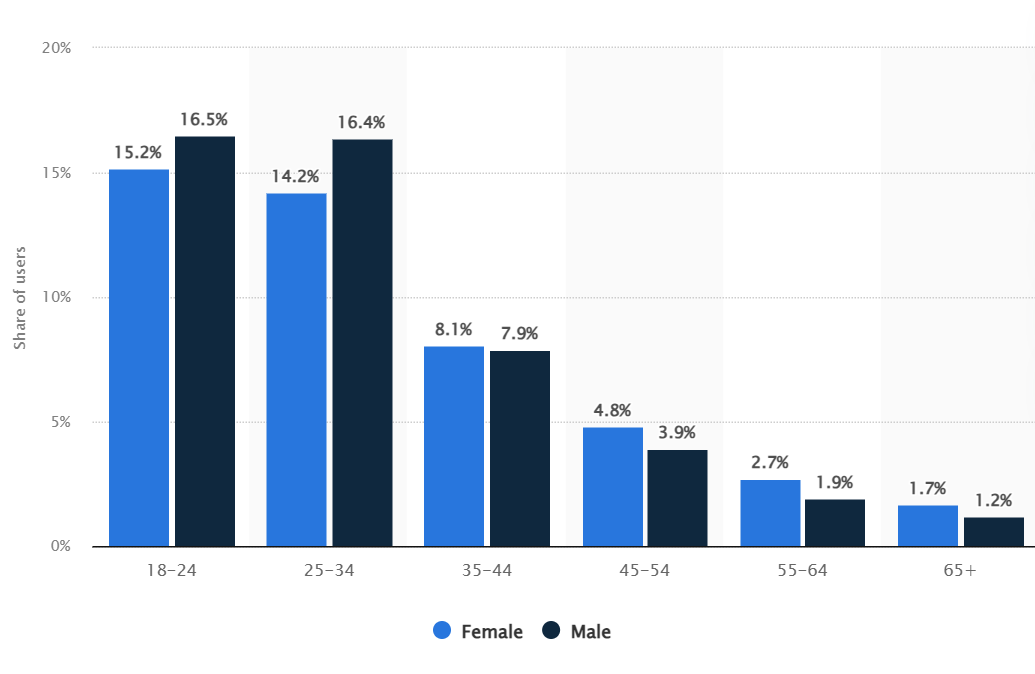
Different Platforms and Their Strengths
Not all social media platforms work the same way. Each has its strengths, making it important for businesses to choose the right one based on their goals and audience.
Facebook: Best for Building a Loyal Audience and Running Ads
Facebook is one of the most popular social media platforms, with billions of users worldwide. It is ideal for businesses that want to build a community and run targeted ads. Facebook Groups, live streams, and interactive posts make it easy to engage with customers and keep them coming back.
“A fitness brand can create a private Facebook group where members share workout tips, ask questions, and get exclusive discounts. This builds a sense of community and keeps customers connected to the brand”.
Instagram: Perfect for Visual Storytelling and Influencer Marketing
Instagram is a highly visual platform, making it perfect for businesses that rely on strong imagery and video content. Features like Stories, Reels, and IGTV stand for Instagram TV allowing brands to create engaging content that captures attention quickly.
“A beauty brand can partner with influencers to showcase how their products work in real life. A makeup artist could post a short tutorial using their products, encouraging followers to try them”.
LinkedIn: Ideal for B2B Networking and Professional Growth
LinkedIn is the go-to platform for business professionals and B2B companies. It’s great for sharing industry insights, networking with potential clients, and establishing authority in a specific field.
“A digital marketing agency can share case studies and success stories to attract new clients. They can also join LinkedIn groups to participate in discussions and connect with industry experts”.
Key Differences Between Email Marketing and Social Media Marketing
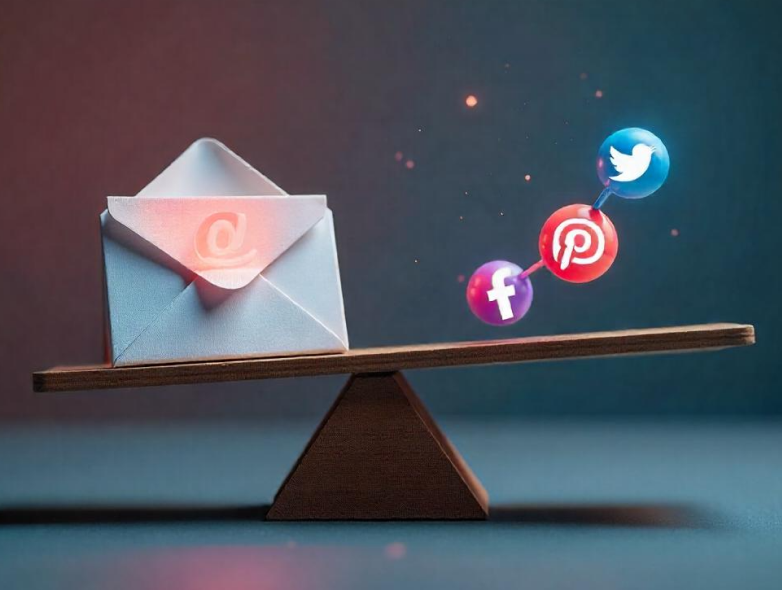
Understanding the differences between email marketing and social media marketing helps businesses choose the right strategy to reach their audience effectively. While both are powerful digital marketing tools, they work in different ways and offer unique advantages.
Direct Communication vs. Mass Engagement
One of the biggest differences between email marketing and social media marketing is how businesses communicate with their audience. Email marketing delivers messages directly to a person’s inbox, making it a one-on-one communication method that feels personal and tailored. This approach allows businesses to create highly customized messages, segment their audience, and build long-term relationships. On the other hand, social media marketing focuses on mass engagement. Businesses post content on platforms like Facebook, Instagram, and Twitter, where it can be seen, shared, and commented on by a broad audience. Unlike emails, which stay in an inbox until read, social media posts have a shorter lifespan, as they quickly get replaced by new content in a user’s feed.
Ownership of Audience
With email marketing, businesses fully own their email list, meaning they can always reach their customers without relying on third-party platforms. This gives them complete control over their audience and ensures that no matter what changes occur in digital trends, they can continue communicating with their subscribers. However, in social media marketing, businesses do not own their audience. Platforms like Facebook and Instagram control how content is distributed, and their algorithms determine how many people actually see a post. This means businesses may need to invest in paid promotions to maintain visibility. While social media allows for massive reach, businesses are dependent on platform policies, making it a less stable long-term strategy compared to email lists.
Long-Term Value vs. Viral Potential
The long-term value of email marketing is significantly high because emails remain in a person’s inbox until they take action. Subscribers who willingly join an email list are already interested in the brand, making them more likely to engage with offers, promotions, and content. Meanwhile, social media marketing thrives on viral potential, where content can quickly gain widespread attention through likes, shares, and comments. While a single social media post can reach thousands of people overnight, engagement levels fluctuate, and posts have a short lifespan. Email subscribers tend to remain loyal over time, whereas social media followers may lose interest or stop seeing a brand’s posts due to changing platform algorithms.
“Is What sApp Social Media Marketing?
Yes, WhatsApp can be used for social media marketing. While it’s primarily a messaging app, businesses use it to engage customers, send promotions, and provide customer support. With WhatsApp Business, brands can automate messages and build strong customer relationships”.
Statistics of Email Marketing & Social Media Marketing
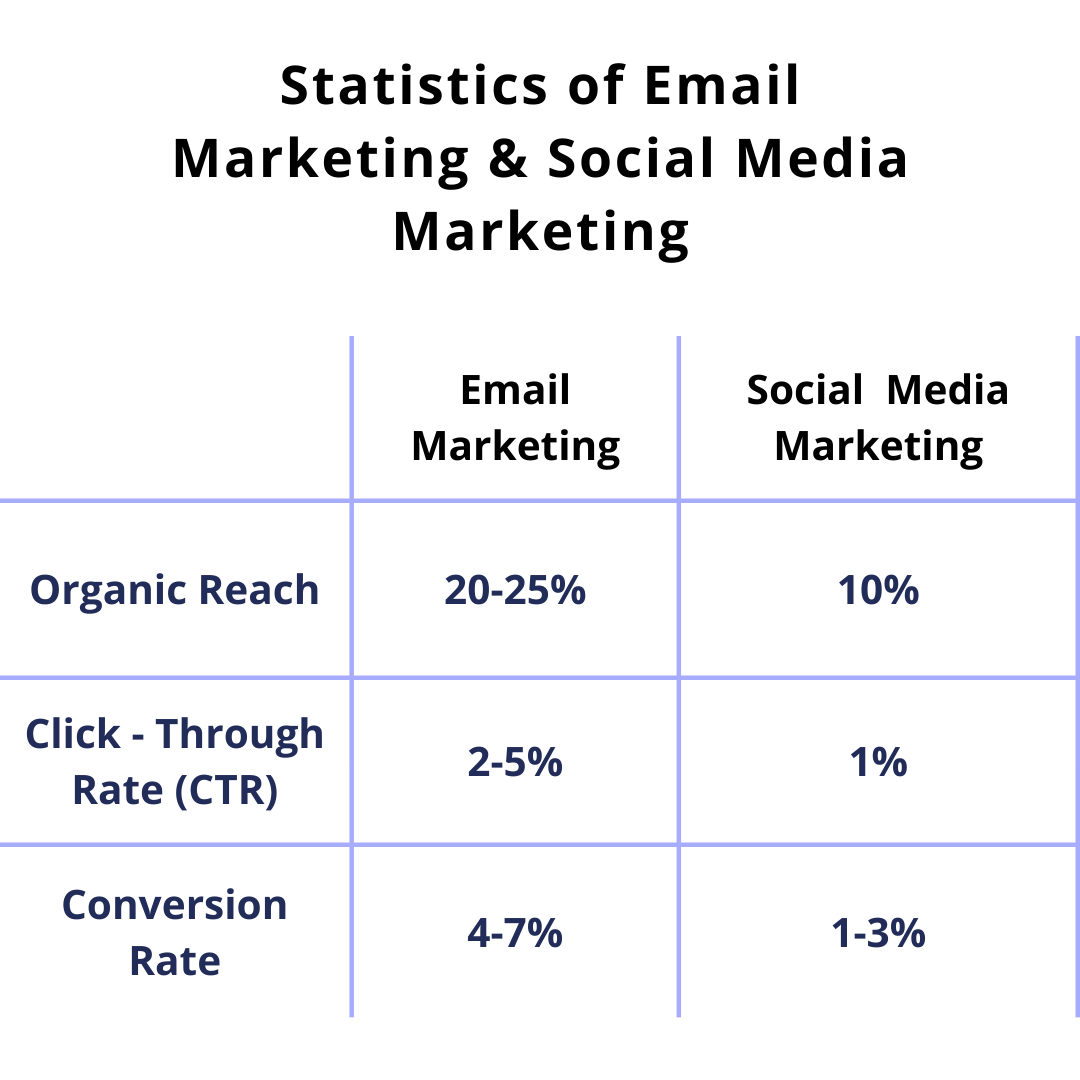
When comparing email marketing vs. social media marketing, open rates and reach reveal a clear difference. Email marketing statistics show that the average email open rate is around 20-25%, meaning a significant portion of recipients engage with the content directly in their inbox. Meanwhile, social media statistics highlight a decline in organic reach, with platforms like Facebook and Instagram averaging only about 5% reach per post. This means businesses must rely on paid ads or frequent posting to maintain visibility. While email marketing ensures direct communication, social media marketing offers broader exposure but with lower guaranteed engagement.
Which Is Better: Email or Social Media Marketing?
Choosing between email marketing vs. social media marketing depends on your business goals. Email marketing works best when you want to nurture leads, send personalized promotions, and build long-term customer relationships. It allows businesses to directly reach their audience, making it ideal for exclusive discounts, product updates, and loyalty programs. For example, Amazon uses email marketing to send personalized product recommendations based on customer browsing history, increasing engagement and sales.
On the other hand, social media marketing is more effective for boosting brand awareness, engaging with audiences in real time, and running targeted ad campaigns. It helps businesses reach new customers through viral content and interactive posts. Brands like Nike leverage social media marketing by creating impactful campaigns on Instagram and Twitter, using influencer collaborations and trending hashtags to maximize visibility. While email marketing statistics prove that emails generate higher conversions, social media ROI comes from instant engagement and broad audience reach. A smart strategy combines both email marketing for direct customer connections and social media marketing for brand expansion.
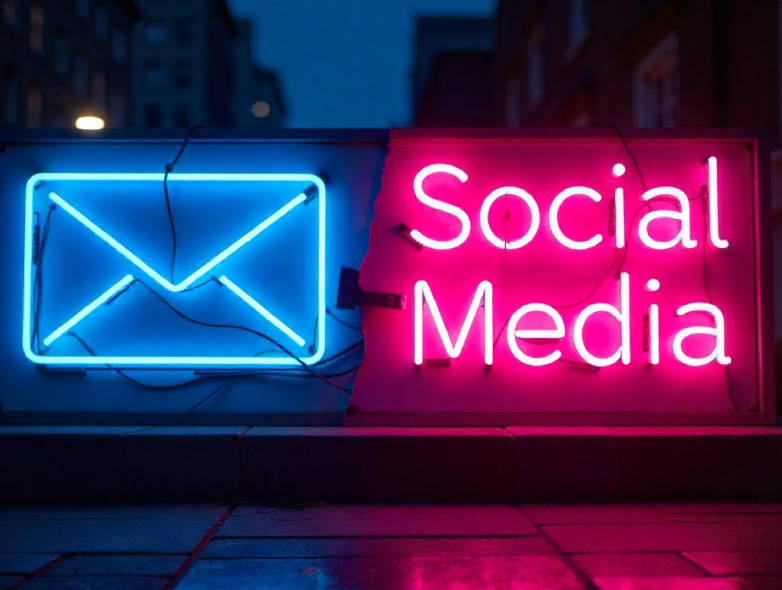
How to Combine Email Marketing and Social Media Marketing for a Winning Strategy
To get the best results, businesses should not see email marketing vs. social media marketing as a competition but rather as a powerful combination. Social media marketing is a great way to attract and engage new audiences through interactive content, ads, and viral trends. By sharing valuable posts, running giveaways, and using influencer marketing, businesses can increase brand awareness and encourage people to take action. However, social media followers do not guarantee long-term engagement, as platforms control visibility through algorithms. That’s where email marketing comes in—it allows businesses to capture these interested users and communicate with them directly.
One of the most effective strategies is using social media marketing to drive people to sign up for emails by offering exclusive content, discounts, or early access to products. Once users subscribe, businesses can nurture these leads through email marketing campaigns, such as personalized recommendations, special promotions, and automated follow-ups. This approach ensures a continuous connection with potential customers while improving email marketing ROI. By analyzing email marketing statistics and social media statistics, businesses can track their performance and refine their strategy for maximum engagement and conversions.
Advantages of Email Marketing

Higher ROI
Email marketing ROI is one of the highest in digital marketing. Studies show that businesses can earn nearly 40 times their investment, making it a cost-effective strategy. For example, an e-commerce store sending personalized offers via email can see higher sales than relying solely on ads.
Personalization
Unlike social media, email marketing allows businesses to segment their audience and send personalized messages. Emails can be tailored based on customer behavior, such as past purchases, browsing history, or location. For instance, a clothing brand can send a discount code for winter wear to customers in colder regions while promoting summer collections to others.
Automation
With email marketing, businesses can set up automated sequences that nurture leads and convert them into customers. Welcome emails, abandoned cart reminders, and follow-ups help maintain engagement without requiring manual effort. For example, an online bookstore can send automated recommendations based on a reader’s past purchases, encouraging more sales.
“Is Digital Marketing Better Than Email Marketing?
Digital marketing covers SEO, PPC, content marketing, and social media, while email marketing focuses on direct customer engagement. Both are important—digital marketing boosts visibility, and email marketing drives conversions. The best approach is to use both based on your business goals”
Benefits of Social Media Marketing
Instant Visibility
Social media marketing allows brands to reach a large audience quickly. A well-crafted post can instantly appear in the feeds of thousands of people, creating brand awareness. Unlike emails that need to be opened, social media content is visible as users scroll. For example, a restaurant posting a new menu on Instagram can immediately attract local customers.
Viral Potential
A single viral post can bring massive attention to a brand, something that email marketing vs. social media marketing comparisons often highlight. If a brand creates engaging content, such as a trending challenge or a humorous meme, people are more likely to share it, leading to organic reach without additional costs. A small bakery, for instance, might gain thousands of new customers if a video of their unique dessert goes viral.
Interactive Content
Social media allows businesses to engage with their audience through polls, live videos, and Q&A sessions. This two-way interaction strengthens customer relationships and increases trust. A beauty brand, for example, can host a live Q&A on Instagram to answer skincare questions, making customers feel more connected to the brand.
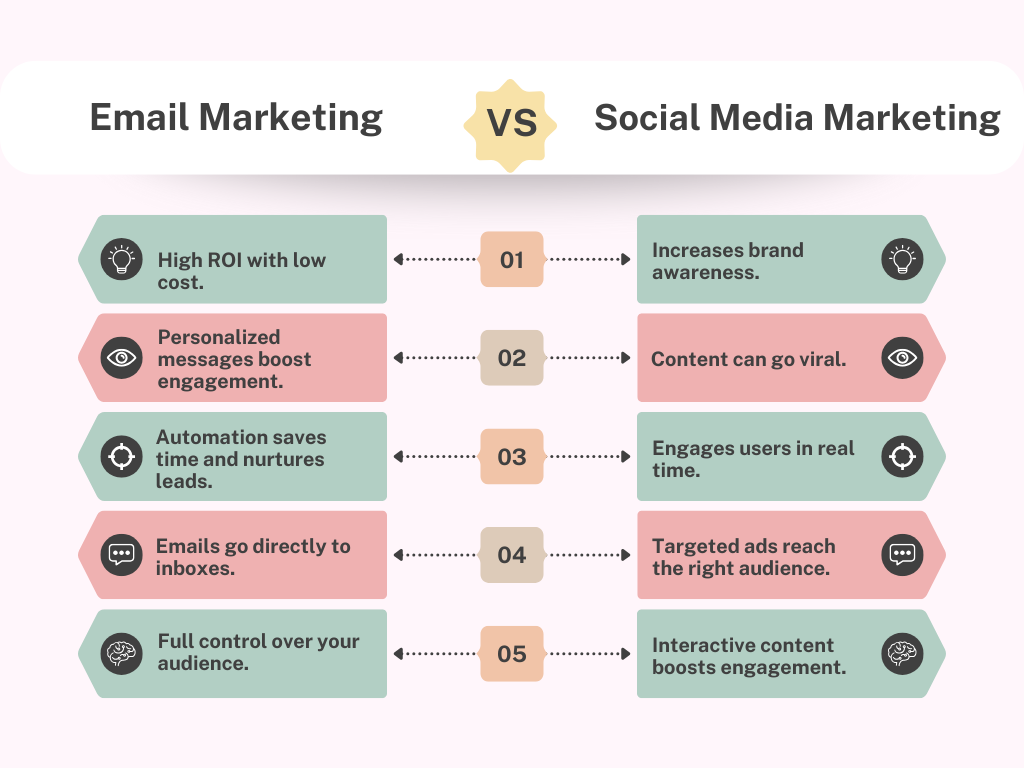
Conclusion
Email and social media marketing each offer unique benefits. Email marketing delivers higher conversion rates, better personalization, and strong ROI, while social media excels at brand awareness and audience engagement.
Instead of choosing one, the best strategy is to combine both. Use social media to attract and engage customers, then leverage email marketing to nurture leads and drive conversions. For example, capturing emails through social media promotions allows businesses to send personalized campaigns that encourage purchases.
Automation enhances both strategies—email sequences like welcome messages and cart reminders maintain engagement, while social media scheduling and targeted ads boost visibility. A balanced approach ensures social media expands your reach, while email marketing builds long-term customer relationships.
At ClickBox Agency, we help brands integrate digital marketing strategies for maximum impact. Our expertise in branding, design, and automation ensures your business thrives in a competitive landscape.
John Click
Digital Marketer | SEO Copywriter | Content Strategist
Experienced digital marketer with a proven track record in creating compelling content that not only engages audiences but also drives conversions and enhances SEO visibility. My expertise extends beyond marketing strategy to crafting persuasive narratives that resonate with your target audience. I combine data-driven strategies with captivating writing to deliver measurable results, ensuring your brand shines in the digital landscape.
John Click
Digital Marketer | SEO Copywriter | Content Strategist
Experienced digital marketer with a proven track record in creating compelling content that not only engages audiences but also drives conversions and enhances SEO visibility. My expertise extends beyond marketing strategy to crafting persuasive narratives that resonate with your target audience. I combine data-driven strategies with captivating writing to deliver measurable results, ensuring your brand shines in the digital landscape.




 Digital Marketing
Digital Marketing


 Digital Marketing
Digital Marketing Digital Marketing
Digital Marketing



